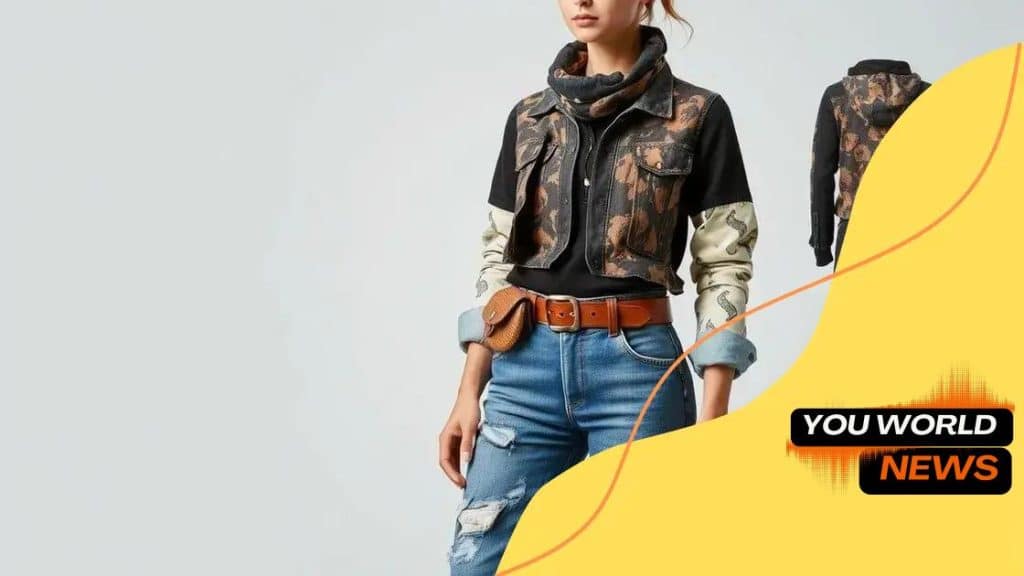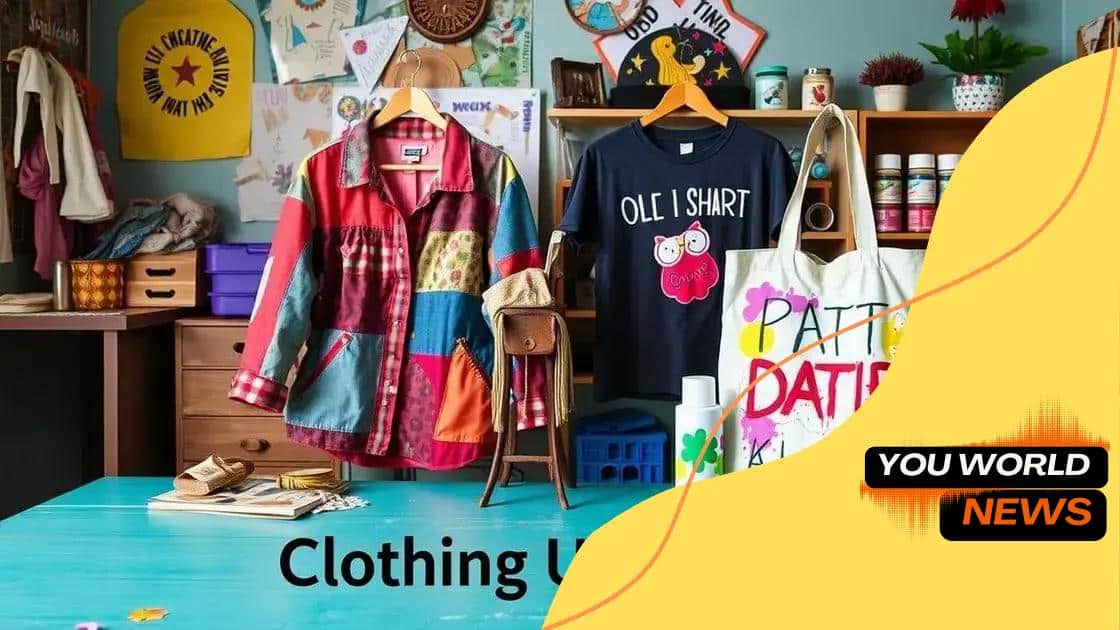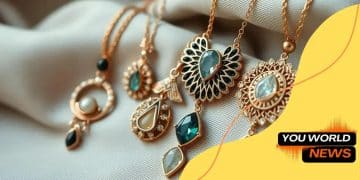Upcycled fashion: turning waste into style and savings

Upcycled fashion transforms old clothing into stylish new pieces, reducing waste and promoting sustainability, making it a key trend in the future of eco-friendly fashion.
Upcycled fashion is changing the way we perceive waste in the clothing industry. It challenges us to rethink what we wear by turning discarded materials into stylish garments. Curious about how this movement can kickstart your sustainable wardrobe? Let’s explore together!
What is upcycled fashion?
Upcycled fashion is a creative movement that turns unwanted materials into stylish clothing. It focuses on giving a new life to items that would typically end up in landfills. In this way, upcycled fashion reduces waste and promotes sustainability.
Understanding Upcycled Fashion
The concept of upcycling is all about transformation. When we upcycle clothing, we take used garments and repurpose them into something new and trendy. This can involve altering, redesigning, or mixing fabrics to create unique pieces.
Benefits of Upcycling
Choosing upcycled fashion has several advantages. Here are some benefits:
- Environmental impact: Upcycling reduces textile waste.
- Unique style: Each piece is one-of-a-kind, reflecting personal creativity.
- Cost-effective: Upcycled items can be more affordable than new clothes.
- Support local artisans: Many upcycled brands work with local craftsmen.
People are becoming more aware of the impact their shopping choices have on the environment. With upcycled fashion, you can express your individuality while making a positive change. Imagine owning a jacket crafted from vintage fabrics, or a bag made from repurposed materials, each with its own story to tell.
How to Identify Upcycled Fashion
When looking for upcycled items, check for brands that prioritize sustainability. They often provide details about the materials used and their production methods. You may find clothing in thrift shops or online stores that specialize in upcycled fashion. Each purchase supports a healthier planet and creative reuse.
As we continue to seek sustainable options, upcycled fashion stands out as a fun and meaningful choice. By embracing this trend, we help reduce waste while enhancing our wardrobes with stylish, unique pieces.
The environmental impact of upcycling
The environmental impact of upcycling is profound. By reusing materials that would otherwise go to waste, upcycling conserves resources and reduces pollution. This process also helps address the growing problem of textile waste, which is a significant contributor to landfill overflow.
Benefits of Upcycling for the Environment
When we upcycle, we significantly cut down on the demand for new materials. This helps decrease energy consumption and lowers greenhouse gas emissions. Each item that is repurposed translates to a reduction in the need for production, making it a win-win for the planet.
Reducing Textile Waste
A staggering amount of clothing ends up in landfills each year. Upcycling helps by extending the lifecycle of these items. Instead of being discarded, garments are transformed into something useful and stylish. By upcycling, we can:
- Minimize landfill contributions.
- Support a circular economy.
- Conserve water resources used in fabric production.
- Lower our carbon footprint.
As consumers become more environmentally conscious, they are seeking out sustainable options like upcycled fashion. This shift not only promotes creative reuse but also fosters a culture of responsibility toward the environment.
In addition, many upcycled products are made using less hazardous processes than traditional manufacturing methods, which often involve toxic dyes and chemicals. By choosing upcycled items, we support safer production techniques and promote a cleaner, greener future.
Creative ways to upcycle clothing

Upcycling clothing is a fun and creative way to breathe new life into your wardrobe. There are countless ways to take old garments and transform them into something fresh and stylish. Whether you’re an experienced crafter or just starting, you can easily find methods to create unique pieces.
Ways to Upcycle Your Clothes
One of the simplest ways to start upcycling is with basic sewing techniques. Even if you don’t know how to sew, there are no-sew options that can still produce fabulous results. Here are some creative ideas:
- Patchwork designs: Combine various fabrics to create a patchwork jacket or bag.
- Fringe and tassels: Add fringes to old jeans or skirts for a fun texture.
- Transforming t-shirts: Turn an old t-shirt into a trendy tote bag.
- Customized embroidery: Use embroidery to personalize clothes and make them unique.
Using fabric paint is another excellent way to craft new styles. You can create your own designs or patterns to give your clothing a fresh update. This method allows you to express your personality while being eco-friendly.
Creative Techniques for Upcycling
Some methods of upcycling clothing require a bit more creativity but yield stunning results. For example, you can turn a full-length dress into a cute two-piece outfit or a long skirt. This way, you get two new looks from one garment.
Another idea is to use old sweaters to make cozy mittens or socks. These projects can be excellent gifts or stylish pieces for yourself. The possibilities with upcycling clothing are limited only by your imagination.
Online tutorials and inspiration boards are great resources for discovering new upcycling ideas. Exploring platforms like Pinterest can help spark your creativity. Whether you choose simple or complex projects, the act of upcycling not only reduces waste but also leads to one-of-a-kind fashion that reflects your style.
How to start your upcycled wardrobe
Starting an upcycled wardrobe is an exciting way to embrace sustainability while enhancing your style. It involves creatively transforming existing clothing items into new, fashionable pieces. This not only helps you save money but also contributes to a healthier planet.
Assess Your Current Wardrobe
The first step in creating an upcycled wardrobe is to evaluate what you already own. Take a look at your closet and identify items that you no longer wear. These could be clothes that no longer fit, are out of style, or need minor repairs.
Choose Your Upcycling Projects
Once you’ve selected the clothes to upcycle, think about the projects you’d like to attempt. Here are some popular ways to get started:
- Refashioning: Change the style of a clothing item. For example, transform a long dress into a trendy blouse and skirt set.
- Repair and embellish: Fix holes or tears and add embellishments like patches, buttons, or embroidery.
- Mix and match: Combine parts from different garments to create a completely new look.
- Accessorizing: Use leftover fabric to create unique accessories, such as headbands or bags.
Next, gather the tools you’ll need for your projects. You might want to have a sewing machine, fabric scissors, needles, and threads at hand. Many upcycling projects also require minimal skills, making them accessible to everyone.
The Upcycling Process
As you begin working on your upcycled wardrobe, remember to let your creativity shine. There are no strict rules when it comes to designing your items. Browse online for tutorials and inspiration to guide your efforts. You might even want to join local crafting groups or online communities to share ideas and resources.
Regularly updating your wardrobe with unique, upcycled pieces ensures that your style remains fresh. It also gives you a sense of accomplishment, knowing that you are making a positive impact on the environment while looking great.
The future of sustainable fashion
The future of sustainable fashion looks promising as more consumers and brands embrace eco-friendly practices. As awareness of environmental issues grows, the demand for sustainable clothing increases. This shift indicates a significant change in the fashion industry.
Trends Shaping Sustainable Fashion
Several trends are emerging that will shape the future of fashion. Brands are starting to prioritize ethical production methods. Consumers are increasingly searching for clothing made from recycled materials. Here are some key trends:
- Transparency: Consumers want to know where their clothes come from and how they are made.
- Innovative materials: Fabrics made from plant-based resources or recycled materials are gaining popularity.
- Renting and swapping: Instead of buying new clothes, renting or swapping items is becoming more common.
- Personalization: Customized clothing options allow consumers to choose styles that reflect their individuality.
Another significant change in the fashion industry is the rise of second-hand shopping. Thrift stores and online resale platforms have gained popularity. Many people now see value in pre-owned clothing, reducing waste and promoting a circular economy.
Impact of Technology on Sustainable Fashion
Technology plays a crucial role in shaping the future of sustainable fashion. New innovations are making it easier for brands to produce clothes responsibly. For instance, advancements in fabric technology allow companies to create sustainable materials more efficiently. Additionally, digital platforms provide a space for brands to connect with conscious consumers.
As fashion continues to evolve, the focus on sustainability will only grow stronger. This can lead to better practices, reducing the industry’s overall environmental impact. With more individuals advocating for change and supporting sustainable brands, the future of fashion is set to be greener and more innovative than ever.
In conclusion, the journey towards sustainable fashion is not just a trend; it’s a movement that reshapes the clothing industry. By embracing upcycled fashion, we take an active role in reducing waste and protecting the environment. Every piece of upcycled clothing tells a story, showcasing creativity and individuality. As we look ahead, the future of fashion holds exciting possibilities, driven by innovation and conscious choices. Together, we can make a significant impact, one stylish outfit at a time!
FAQ – Frequently Asked Questions about Sustainable Fashion
What is upcycled fashion?
Upcycled fashion involves taking old clothing items and creatively transforming them into new, stylish pieces, reducing waste and promoting sustainability.
How does upcycling benefit the environment?
Upcycling reduces textile waste, lowers greenhouse gas emissions, and lessens the demand for new resources, making it an eco-friendly choice.
What are some easy projects to start upcycling?
Simple projects include turning t-shirts into tote bags, adding patches to jeans, or creating unique accessories from fabric scraps.
Why is transparency important in sustainable fashion?
Transparency allows consumers to understand the production process, ensuring that brands align with ethical and sustainable practices.





